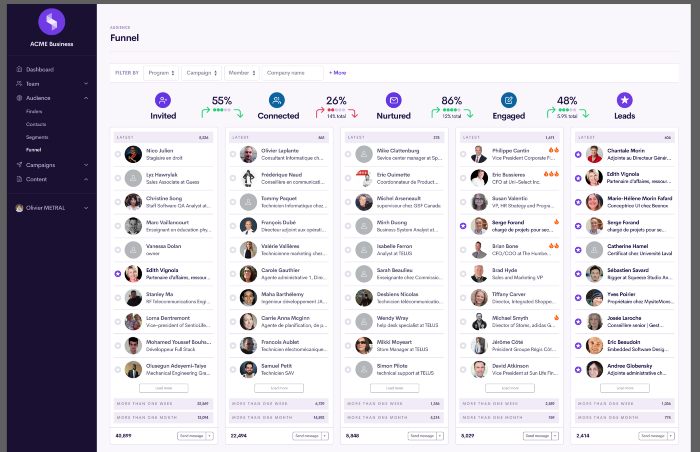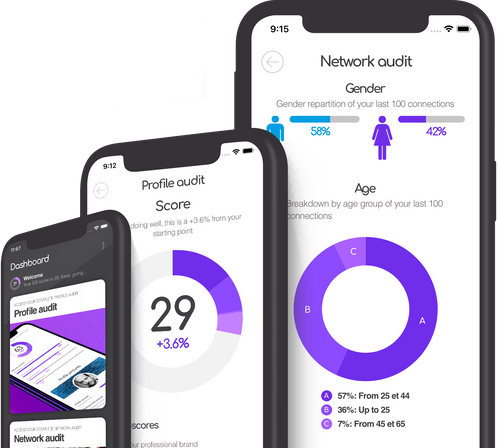Unleash your full social selling potential
As an entrepreneur in the software industry, I’ve had to learn in the field which communications and marketing channels work to publicize products and services. And I’ve often had to find out the hard way that what wasn’t working wasn’t just wasting time but also costing me a lot of money. Above all, I’ve come to understand that what worked best was based on common sense. My ultimate conclusion? Bet big on your LinkedIn network!
Here are three essential steps that you absolutely need to integrate into your regular work routine if you want to get real, tangible results with LinkedIn.
1. Develop your network with target contacts
You need to know very precisely who you need to talk to. Persuasion is a difficult endeavor, and you don’t want to waste your time and your energy trying to persuade the wrong people. You need to be able to define distinct criteria at a fine level in order to define the typical profiles of the people you want to invite to join your network.
Obviously, these criteria will vary according to your situation and business context, but these are the ones that you need at a minimum if you’re in B2B:
Your buyer’s position or department.
Their interest in your product or service will vary based on this, which will therefore influence both the content and the form of your discourse.
Their language.
You’ll need to be able to hold a conversation with them as needed.
Their industry.
You’ll need to be able to provide them with references in similar domains of activity, or provide pertinent feedback that your contact can readily identify with.
The size of the company.
If this particular one doesn’t seem vital to you, think again, because you’re probably overreaching right now.
Their geographic location.
You or your partners need to be able to travel to meet your buyer in person.
This first step of defining criteria is important, because it lets you rethink your targets. Identifying your buyer’s typical profile is a good exercise, but properly formalizing it is even better. To help with this, you can use one of the many Buyer Persona definition models available online.
The next step is to locate the right people, which is probably the number one reason we use LinkedIn in the first place. Having access to a continuously updated database of hundreds of millions of contacts is an incredible luxury, and you need to take full advantage of it. For this, you absolutely need a LinkedIn Sales Navigator license, so work something out with your employer if you have to. With Sales Navigator, you can create saved searches based on profile criteria you’ve identified and then invite the people your searches found to join your network.
Your LinkedIn network is your own asset. It’s a preferred distribution channel to publish your content, and lets you personally interact with your prospects. Here are some tips on how best to manage your network:
Don’t send too many invitations
, for two reasons: First, LinkedIn can penalize you if you send too many invitations in a day, especially if you don’t have a good acceptance ratio. The second reason is that you need to maintain control of the volume of invitations. You’ll have difficulty with the next two tips if you have too many connections. Limit yourself to around 50 invitations sent per day.
Be selective when accepting invitations.
Keep in mind that you don’t have an unlimited number of first-degree connections — you’re limited to a
. And even if that seems like a huge number, you can easily reach it in three years (or even less) if you get too caught up in it.
Clean up your sent invitations.
LinkedIn sets
too: you can no longer send any new invitations once you’ve reached 3,000 invitations sent but not accepted. Also, keep in mind that you can no longer re-invite someone for three weeks if you’ve cancelled a previous invitation you sent them.
2. Publish relevant content regularly
Social media is now an integral part of the buying decision cycle. A buyer will most likely discover and then start looking closer at your product or service through a post on Facebook, Twitter, Instagram or LinkedIn. Good luck if you don’t have a presence on these platforms, and good luck too if you think your potential buyers — not to mention your competitors — aren’t already active there.
However, succeeding on social media and being seen a real sales professional in the eyes of your buyers poses a significant challenge. Your contacts expect you to bring them value, so you must always provide useful and pertinent information.
If your marketing team makes ready-to-use corporate content available to you, consider yourself lucky to have this precious resource — start posting it! Otherwise, you’ll unfortunately have to find your own solutions to produce and distribute original content. This is my case, and here’s my routine:
Subscribe to publications in my industry and to specialized blogs, and also follow some social media influencers.
Do a daily (or at least bi-weekly) review of my recent publications and identify which ones got the most reactions from my audience.
Keep a list of ideas for my own publications — just a preliminary title with a few key points, and make sure to note (and bookmark) all of the reference articles I’ve found.
Set aside one evening per week (or at least per month) to write. For those who don’t like to write, use your marketing team’s writers, or hire some freelancers.
Share content by direct message to a few key people in my network contacts and ask for their advice. It’s a great opportunity to exchange ideas.
Proceed to share that content by publishing it in my news feed. One hour is a good time limit to for a first reaction.
Your goal isn’t quantity but rather consistency. You can decide to publish content daily, weekly or monthly — whatever schedule you decide on, just stick to it. Here’s a good exercise: Take a look at how much content you published on LinkedIn or another social media platform last week, last month and over the last six months; at the same time, take a look at the frequency of your posts.
Once you’ve gotten into a regular publishing routine, make sure to pay special attention to anyone who appears to have immediately taken an interest in you, such as people who have gone to view your profile or who have reacted to your posts with a like or a comment. You’ve already gotten somewhere with them, so send them a personalized note to invite them to join your network.
3. Segment your network and identify your hot prospects
You need to identify your criteria for what makes a contact warm enough to start your sales cycle. My advice is to create your own scale around the four main pillars of lead scoring:
Demographic criteria
that indicate if a contact’s profile corresponds to your target criteria, such as their current position, how long they’ve held it, and their region.
Firmographic criteria
that indicate if the company your contact works for corresponds to your criteria, such as the size of the organization, the industry or the rate of the company’s growth.
Relational criteria
pertaining to what brings you closer to your contact. The key is to become part of their Level 1 network. You can take into account things like whether they’ve consulted your profile, whether you have common contacts or whether you’re subscribed to some of the same groups.
Behavioral criteria
indicating the actions that a contact has taken regarding you or your company, such as whether they’ve visited your website, downloaded one of your white papers, registered for one of your webinars or started a trial of your product.
Demographic, firmographic and relational criteria are simple enough to determine using LinkedIn alone. Behavioral criteria, however, are more difficult to correlate because they are often derived from your marketing tools. As such, you need to work hand-in-hand with your marketing team to cross-reference this information.
Once you’ve reached your Tier 1 segment, the people with whom you need to get a conversation going, you can mark these contacts as prospects saved in Sales Navigator, or export them to your CRM and start your traditional sales cycle.
This process might seem long and complex, and perhaps you don’t have the skills or tools to implement it. At stent.io, we’re developers and entrepreneurs who have been in exactly the same situation — and this is precisely what drove us to create an innovative digital platform that helps sales teams kick start and then maintain this routine, all while boosting each team member’s own social selling potential.

Stent leverages the latest intelligent automation technologies to deliver the very best contacts to you — all of the right people at just the right time. Discover your own social selling potential by downloading the free Stent mobile app, available for iOS and Android.

